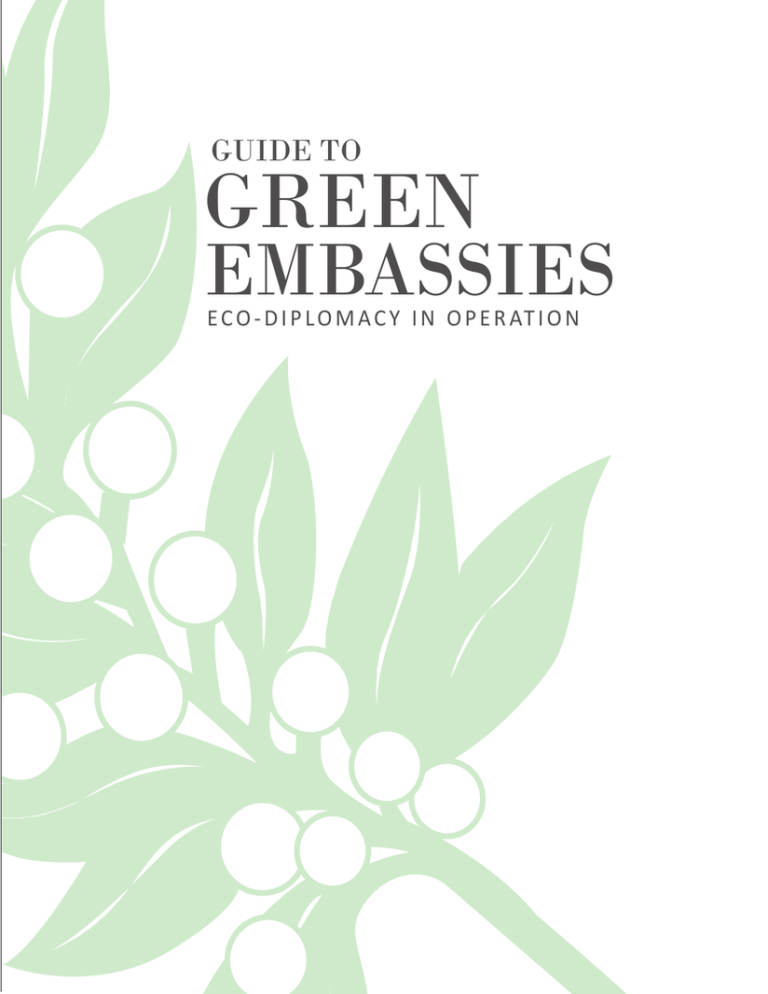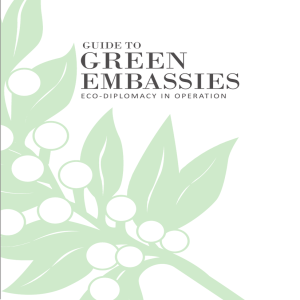GREEN EMBASSIES GUIDE TO
advertisement

GUIDE TO GREEN EMBASSIES E C O - D I P L O M A C Y I N O P E R AT I O N Credits GUIDE TO GREEN EMBASSIES Managers OBO/PDCS/DE: William Miner, Office Director OBO/PDCS/DE/ESD: Donna McIntire, Chief Melanie Berkemeyer, Managing Editor Danielle Sines, Graphic Design Manager EC O - D I P LO M A C Y I N O P E R AT I O N Authors and Producers U.S. Department of State Mission To create a more secure, democratic, and prosperous world for the benefit of the American people and the international community. Greening Council Mission and Guiding Principles To improve the Department’s environmental footprint and increase efficiencies, by harnessing expertise in policy, management, and public diplomacy from grass roots to senior management, in order to cultivate and institutionalize sustainability efforts, measure and report progress, and challenge others by fulfilling our environmental commitments and highlighting our successes. • Implementing best practices in design, construction, and operation of facilities • Leveraging information technology to support high performance and efficiencies • Minimizing energy consumption and increasing cleaner energy use • Using environmentally preferable products and reducing waste streams • Protecting and conserving water • Optimizing ecosystems services • Enhancing indoor environmental quality to support occupant well-being and productivity • Advancing U.S. efficient, clean energy and sustainable technologies and services Bureau of Overseas Buildings Operations Mission To provide safe, secure, and functional facilities that represent the U.S. government to the host nation and support our staff as they work to achieve U.S. foreign policy objectives. The Department’s facilities should represent the best in American architecture, design, engineering, technology, sustainability, art, culture, and construction execution. Paladino and Company: Tom Paladino, Brad Pease, Wanda Lowrey, Lexy Relph, Megan Snyder, Grey Fowles, Andrew Lee, Maggie Santolla, Hanna VanOverschelde, and Kelley Manuel Contributors OBO/PDCS/DE/ESD: Robert Jeter, Water and Site Chapter Lead Beth Kempton, Residential Chapter Lead Dena Richardson, Indoor Environment and Materials Chapter Lead David Shaffer, Energy Chapter Lead A/OPR/GSM: Chappell Garner, Transportation Chapter Lead OBO/EA: Christine Foushee, Amanda Hauck, and Angelina Rotella OBO/PDCS/DE/AD: Tetsuya Yamamoto OBO/PDCS/DE/EE: Richard Moss OBO/PDCS/DE/ME: Joseph Cafferata OBO/PDCS/PDC: Lisa Bolten OBO/OPS/SHEM: Claire Huson, Ronald Martin, and Regina McClelland OBO/CFSM/FAC: Fernando Ospina OBO/CFSM/CM/CS: Stanley Scofield M/PRI: Landon Van Dyke A/OPR/FMS: Janice Smith and Mico Miller IRM/BMP/SPO/SPD: Robert Glunt and Cecelia Henderson League of Green Embassies: John Molesky Franklin Fellow: Todd Fein Peer Reviewers Department of State Foreign Service: Jennifer Johnson, Santiago Laura Garcia Olson, Lagos General Services Administration: David Bosley, Amanda Dean, Andrea Azarcon Heller, and Melissa Walker OBO Industry Advisory Group: Michael Beirut, Penny Bonda, and William Browning 100% Foreword A Message from the Secretary I am very pleased to endorse the second edition of the Guide to Green Embassies Eco-Diplomacy in Operation (the Guide). This new edition expands on U.S. Secretary of State Kerry the success of the initial Guide, continuing the environmental sustainability leadership of former Secretary of State Hillary Clinton and the efforts initiated by Under Secretary for Management Patrick Kennedy—the U.S. Department of State’s Senior Sustainability Officer. Both of these inspired leaders deserve my thanks and appreciation for the foundation they established. New to this second edition is a chapter on residential strategies, as well as information throughout the Image Source: U.S Department of State Guide on staff engagement. These additions are priorities that I support to build on the Department’s sustainability leadership. The Guide provides comprehensive and useful information for mission staff— at every level—to fully integrate into their daily practices, both on a personal and professional basis. The Guide is organized in a hands-on way so that mission staff can take immediate action to green their homes and offices. This second edition will be key to achieving the Department’s sustainability goals and inspiring the global community. John F. Kerry Secretary of State Guide to Green Embassies Eco-Diplomacy in Operation Table of Contents INTRODUCTION USING THIS GUIDE TRANSPORTATION SITE WATER ENERGY MATERIALS INDOOR ENVIRONMENT RESIDENTIAL GLOSSARY INTRODUCTION Introduction The Case for Change According to the U.S. Environmental Protection Agency (EPA), the earth’s average temperature has risen by 0.8 degrees Celsius (⁰ C) (1.4 degrees Fahrenheit (⁰ F)) over the past century and is projected to rise another 1.1–6.4⁰ C (2.0–11.5⁰ F) by 2100.1 The Intergovernmental Panel on Climate Change (IPCC) 2013 report states, “It is extremely likely that human influence has been the dominant cause of the observed warming since the mid-20th century.”2 The IPCC also says the building sector has more potential to deliver quick, deep, and cost effective greenhouse gas (GHG) mitigation than any other. Energy consumption in both new and existing buildings could be cut by an estimated 30-50% by 2020 through readily available technologies, design, equipment, management systems, and alternative generation solutions. This can be funded through investments that quickly payback and result in significant environmental, social, and economic benefits. In the context of complex international dynamics and evolving energy prices, as well as limited access to clean freshwater and a growing depletion of finite natural resources, environmental stewardship is critical. This is particularly true given the impact of the building sector and the breadth of the federal government’s real estate portfolio. The U.S. government owns approximately 445,000 buildings with a total floor space of over 300 million square meters (m2) (3.23 billion square feet (ft2)) and leases approximately 57,000 buildings with a total floor space of over 34.7 million m2 (374 million ft2). These buildings account for 37% of the government’s total energy use.3 The U.S. Department of State (the Department) is responsible for more than 7 million gross m2 (75.3 million gross ft2) in 19,000 facilities, supporting U.S. embassy missions in 190 countries. In October 2013, Secretary of State John Kerry said: …the energy used to power buildings accounts for about one third of all global energy demand and regrettably almost 40 percent of all of our associated CO2 emissions….by greening our embassies, we are really taking one other important step in the effort to try to contribute to a larger effort with buildings around the world…our embassies ought to also reflect the very best of American design architecture, and they ought to reflect our commitment to sustainability and to technology. They are the model of American innovation in this field and they reflect our deep commitment to responsible environmental stewardship.4 Since 1999, the Department’s Bureau of Overseas Buildings Operations (OBO) has worked to increase the performance of its 275 embassies and consulates i Guide to Green Embassies Eco-Diplomacy in Operation around the world to provide safe, secure, functional, and sustainable platforms from which to conduct diplomacy. OBO has improved conditions for Americans overseas through new construction, major renovations, and systems upgrades, and moved more than 30,000 employees to 108 new and over 200 renovated facilities. While issues of security and required maintenance take priority over energy and sustainability, recent federal performance goals have demonstrated the interconnection of these concerns.5 Providing and maintaining sustainable buildings, grounds, and operations allows OBO to effectively demonstrate the intersection of security and sustainability as it literally and figuratively builds the foundation for eco-diplomacy. Federal Performance Goals • • Executive Order (EO) 13514 • • • • • EO 13423 • Report a comprehensive annual inventory of GHG emissions. Inventory shall include purchased energy, employee travel and commuting miles, solid waste disposal, and wastewater treatment. Reduce energy intensity by 30% by 2015 using 2007 baseline. Reduce potable water consumption intensity by 26% by 2020 using 2007 baseline (2% per year). Reduce irrigation water intensity by 20% by 2020 using 2010 baseline (2% per year). Divert 50% of non-hazardous solid waste by 2015. Ensure that 95% of new contracts require sustainable products and services. Ensure that 15% of real property assets are sustainable for buildings larger than 464 m2 (5,000 ft2) by 2015. Reduce fleet fossil fuel consumption by 30% by 2020 using 2005 baseline. Energy Independence and Security Act (EISA) • • Increase alternative fuel use by 10% each year. Provide one renewable fuel pump per fueling center by 2010. Energy Policy Act (EPAct) • Conduct a feasibility study by 2013 to determine whether the 7.5% renewable energy use target can be achieved. Underpinning OBO’s work, the Department’s Greening Diplomacy Initiative (GDI) provides a broad internal framework for the Department’s sustainability implementation. GDI challenges the Department to lead by ii INTRODUCTION example, requiring environmental stewardship in both policy and practice. Eco-diplomacy policy and practice foster shared values between nations that are committed to reducing their GHG emissions, conserving natural resources, and increasing biodiversity. Eco-diplomacy is the practice of conducting international relations by facilitating and advancing a shared commitment to conserving natural resources through sustainable operations and responsible environmental stewardship. Through tangible ‘bricks and mortar,’ our embassies and consulates demonstrate America’s commitment to mending and improving the relationship between the built and natural environments while simultaneously promoting U.S. initiatives worldwide and demonstrating America’s values and best practices in sustainability. Call to Action The U.S. government has called for federal facilities to strengthen national security by lessening dependence on foreign oil, thereby strengthening the U.S. economy, lowering energy costs, creating new jobs through new technologies, and reducing global warming. Empowering Leaders A successful response to this Call to Action requires leadership from organizations and individuals at all levels. From Post Green Teams to Chiefs of Mission (COMs), everyone has a role and responsibility to make important contributions. Diplomatic leaders can forge partnerships with local peers and other diplomatic leaders to raise awareness of, and take action on, sustainability challenges. Post management, as well as the Post Green Teams and green champions, can generate and implement ideas, raise awareness, and foster support and action. Five steps for posts to begin their journey toward eco-diplomacy: Step 1 Step 2 Step 3 Step 4 Join the League of Green Embassies (the League) (visit http://www. leagueofgreenembassies.org for more information). Ensure that a Green Team is organized and empowered to lead. Review strategies and resources in the Using This Guide chapter. Develop a sustainability improvement plan. Use the Guide to identify strategies, timelines, and funding sources. Define and incorporate sustainability objectives that align with federal performance goals into post’s strategic plans and annual staff evaluations. iii Guide to Green Embassies Eco-Diplomacy in Operation Step 5 Submit green success stories for annual GDI awards, to recognize staff and promote best practices (visit www.state.gov/green for more information). By leveraging its unique opportunity of global reach and model facilities, the Department can harness the intelligence, resourcefulness, and commitment of its personnel to integrate innovative, high-impact strategies into its daily operations. We, the people, still believe that our obligations as Americans are not just to ourselves, but to all posterity. We will respond to the threat of climate change, knowing that the failure to do so would betray our children and future generations. Some may still deny the overwhelming judgment of science, but none can avoid the devastating impact of raging fires, crippling drought, and more powerful storms. The path towards sustainable energy sources will be long and sometimes difficult. But America cannot resist this transition; we must lead it. We cannot cede to other nations the technology that will power new jobs and new industries; we must claim its promise. That’s how we will maintain our economic vitality and our national treasure—our forests and waterways, our crop lands and snow-capped peaks. That is how we will preserve our planet, commanded to our care by God. That’s what will lend meaning to the creed our fathers once declared. President Barack Obama 2nd Inaugural Address, January 21, 2013 Endnotes 1 US EPA (2012). Climate Change Basics. U.S. Environmental Protection Agency. http://www.epa.gov/climatechange/basics 2 Climate Change 2013: The Physical Science Basis—Summary for Policymakers. Intergovernmental Panel on Climate Change, 2013. http://www. climatechange2013.org/images/uploads/WGI_AR5_SPM_brochure.pdf 3 The Federal Commitment to Green Building: Experiences and Expectations. http:// www1.eere.energy.gov/femp/pdfs/fedcomm_greenbuild.pdf 4 Secretary Kerry Delivers Remarks to the D.C. Greening Embassies Forum. The U.S. Department of State. http://www.youtube.com/watch?v=QUneIlBgmDg 5 Crosswalk of Sustainability Goals and Targets. Federal Energy Management Program, U.S. Department of Energy. https://www1.eere.energy.gov/femp/pdfs/ sustainabilitycrosswalk.pdf iv








